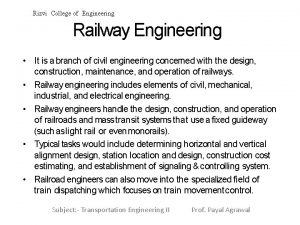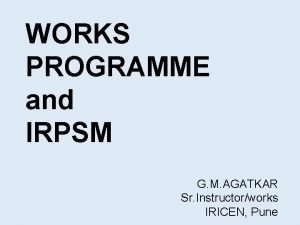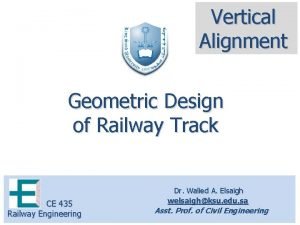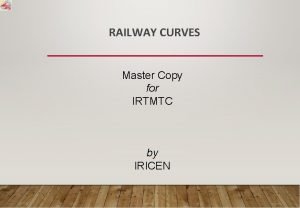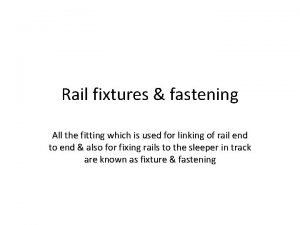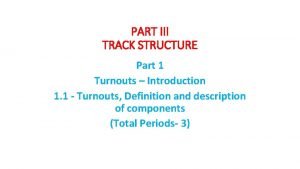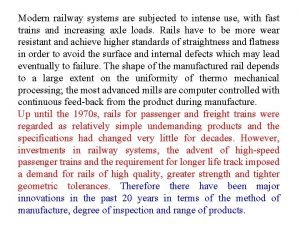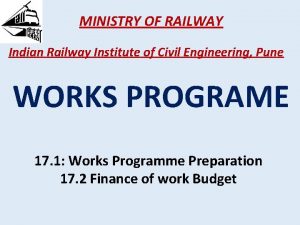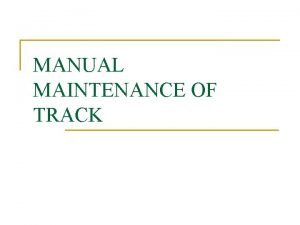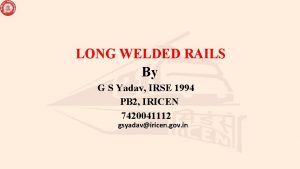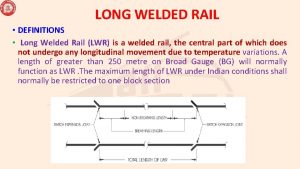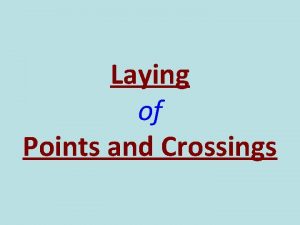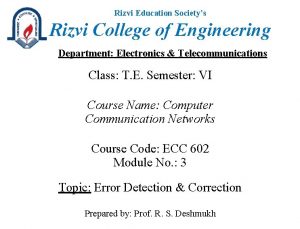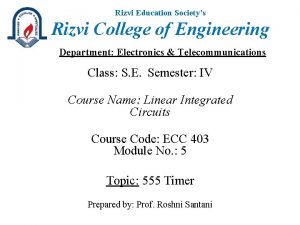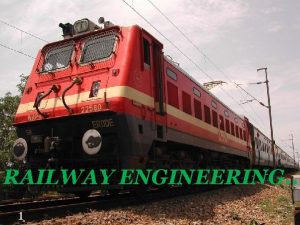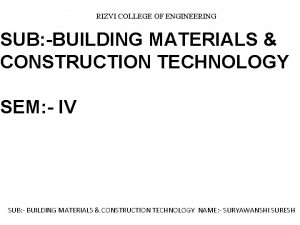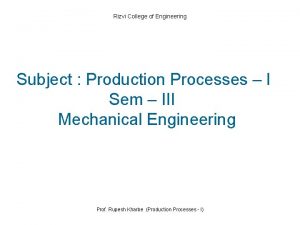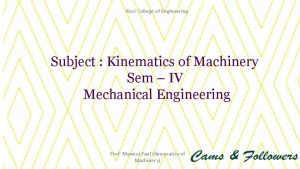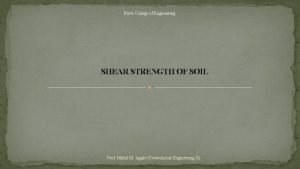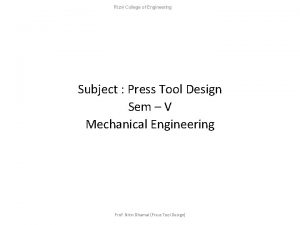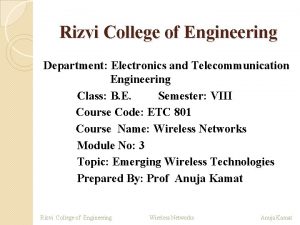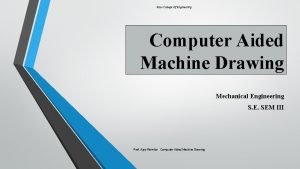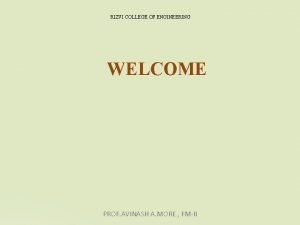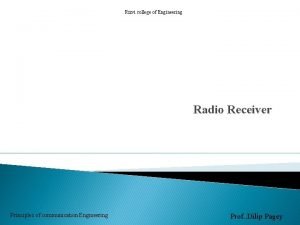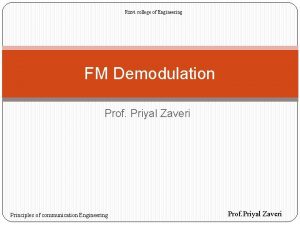Rizvi College of Engineering Railway Engineering It is



















- Slides: 19

Rizvi College of Engineering Railway Engineering • It is a branch of civil engineering concerned with the design, construction, maintenance, and operation of railways. • Railway engineering includes elements of civil, mechanical, industrial, and electrical engineering. • Railway engineers handle the design, construction, and operation of railroads and mass transit systems that use a fixed guideway (such as light rail or even monorails). • Typical tasks would include determining horizontal and vertical alignment design, station location and design, construction cost estimating, and establishment of signaling & controlling system. • Railroad engineers can also move into the specialized field of train dispatching which focuses on train movement control. Subject: - Transportation Engineering II Prof. Payal Agrawal

Rizvi college of Engineering Section of Permanent Way Subject: - Transportation Engineering II Prof. Payal Agrawal

Rizvi college of Engineering Wooden Sleepers • Hard wood such as, sal and teak • Soft wood such as, chir and deodar Subject: - Transportation Engineering II Prof. Payal Agrawal

Rizvi college of Engineering Wooden Sleepers • Hard wood such as, sal and teak • Soft wood such as, chir and deodar Subject: - Transportation Engineering II Prof. Payal Agrawal

Rizvi college of Engineering Wooden Sleepers • Hard wood such as, sal and teak • Soft wood such as, chir and deodar Subject: - Transportation Engineering II Prof. Payal Agrawal

Rizvi college of Engineering Wooden Sleepers • Hard wood such as, sal and teak • Soft wood such as, chir and deodar Subject: - Transportation Engineering II Prof. Payal Agrawal

Rizvi college of Engineering RAIL GAUGE The gauge of a railway track is defined as the clear minimum perpendicular distance between the inner faces of the two rails. Subject: - Transportation Engineering II Prof. Payal Agrawal

Rizvi college of Engineering Dimension of gauges 1. Broad Gauge(BG) 1676 mm(5’ 6”) 2. Standard Gauge(SG) 1435 mm 3. Metre Gauge(MG) 1000 mm 4. Narrow Gauge(NG) 762 mm(2’ 6”) 5. Light Gauge 610 mm Subject: - Transportation Engineering II Prof. Payal Agrawal

Rizvi college of Engineering Coning of Wheels • Coning of wheels – The distance between the inside edges of wheel flanges is generally kept less than the gauge. Gap is about 38 mm on Either side. Normally the tyre is absolutely ahead centre on the head of the rail, as the wheel is coned to keep it in this central position automatically. These wheel are coned at a slope • Theory of coning: - On a level track, as soon as the axle moves towards one rail, the diameter of the wheel tread over the rail increases, while It decreases over the other rail. This prevents to further movement And axle retreats back to its original position (with equal dia or both rails and equal pressure on both rails). Subject: - Transportation Engineering II Prof. Payal Agrawal

Rizvi college of Engineering Coning of Wheel on Level-track Subject: - Transportation Engineering II Prof. Payal Agrawal

Rizvi college of Engineering RAILS The high carbon rolled steel sections, which are laid end-to-end, in two parallel lines over sleepers to provide continuous and leveled surface for the trains to move and for carrying axle loads of the rolling stock are called rails. ` Subject: - Transportation Engineering II Prof. Payal Agrawal

RAILS Types of rails: 1. Double Headed Rails (DH Rails) 2. Bull Headed Rails (BH Rails) 3. Flat-footed Rails (FF Rails) Subject: - Transportation Engineering II Prof. Payal Agrawal

Rizvi college of Engineering Buckling of Rails Buckling means the track has gone out of its original position or alignment due to prevention of expansion of rails in hot weather on account of temperature variations. Subject: - Transportation Engineering II Prof. Payal Agrawal

Rizvi college of Engineering Damaged Rails These are the rails which should be removed on account of their becoming unsafe for a railway track. Subject: - Transportation Engineering II Prof. Payal Agrawal

Rizvi college of Engineering Rail Joints • • • Supported Rail Joint Suspended Rail Joint Bridge Joint Base Joint Welded Rail Joint Staggered or Broken Joint Square or Even Joint Compromise Joint Insulated Joint Expansion Joint` Subject: - Transportation Engineering II Prof. Payal Agrawal

Rizvi college of Engineering Rail Joint Subject: - Transportation Engineering II Prof. Payal Agrawal

Rizvi college of Engineering Insulated Joint Subject: - Transportation Engineering II Prof. Payal Agrawal

Rizvi college of Engineering Expansion Joint Subject: - Transportation Engineering II Prof. Payal Agrawal

Rizvi college of Engineering THANK YOU Subject: - Transportation Engineering II Prof. Payal Agrawal
 Coning of rails
Coning of rails Wake tech admissions
Wake tech admissions Early college high school at midland college
Early college high school at midland college Pwp railway workshop
Pwp railway workshop The pacific railroad act of 1862
The pacific railroad act of 1862 Wagon registration fee
Wagon registration fee Geometric design of railway
Geometric design of railway 019 railway standard
019 railway standard Function of ict
Function of ict Railway network sweden
Railway network sweden Degree of curve in railway
Degree of curve in railway Fang bolt railway
Fang bolt railway Heel of switch in railway
Heel of switch in railway Modern railway systems
Modern railway systems Irwcms login
Irwcms login Boxing of ballast
Boxing of ballast Breathing length of rail
Breathing length of rail Lwr full form in railway
Lwr full form in railway 2005/lml/18/8
2005/lml/18/8 Similar flexure turnout
Similar flexure turnout
